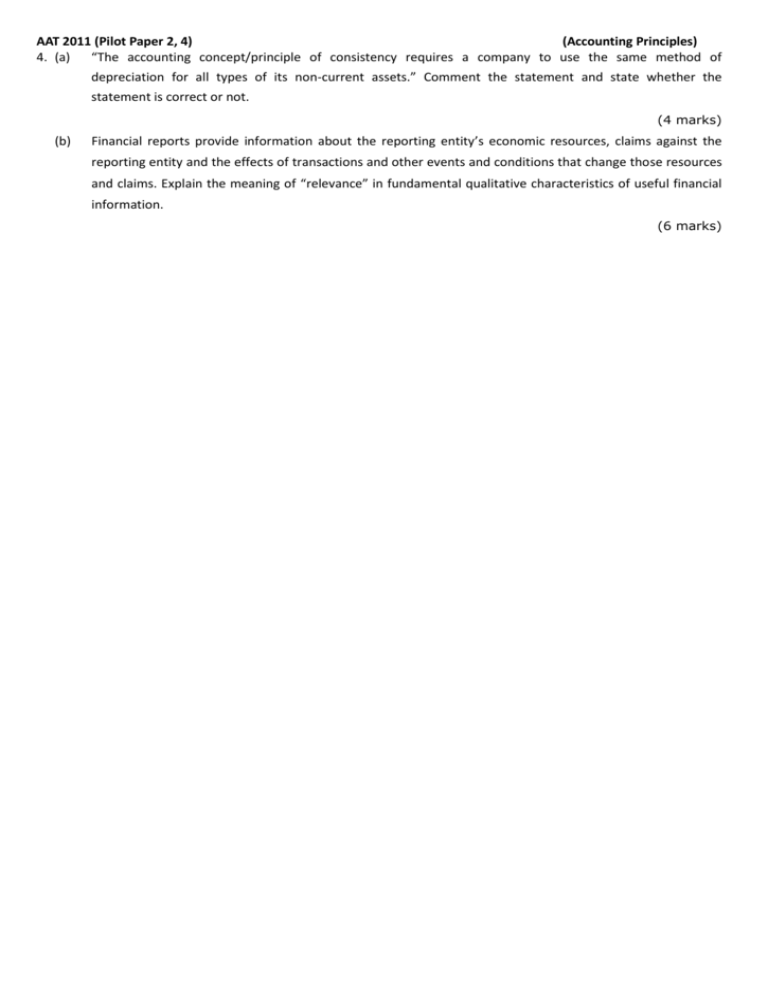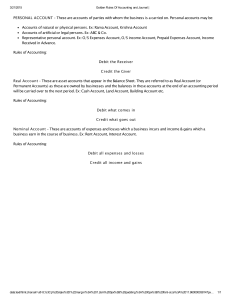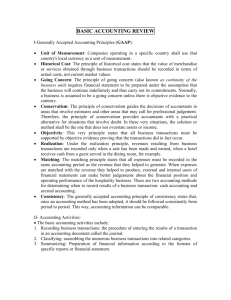Document
advertisement

AAT 2011 (Pilot Paper 2, 4) (Accounting Principles) 4. (a) “The accounting concept/principle of consistency requires a company to use the same method of depreciation for all types of its non-current assets.” Comment the statement and state whether the statement is correct or not. (4 marks) (b) Financial reports provide information about the reporting entity’s economic resources, claims against the reporting entity and the effects of transactions and other events and conditions that change those resources and claims. Explain the meaning of “relevance” in fundamental qualitative characteristics of useful financial information. (6 marks) HKCEE (2010, 1) (Accounting Principles) (A) Lidia Design has employed Bill Chan, a famous and experienced designer, for a contract period of three years. Bill Chan is to be paid a monthly salary of $100,000 plus a commission of 5% on the revenues of his projects. Since the company considers Bill Chan to be a valuable asset of the business, it capitalises an amount of $3,600,000, the total salary payable to Bill Chan, as an intangible asset on its balance sheet. REQUIRED: State the accounting principle or concept that has been violated and give an explanation. (A) Quantifiability Only transactions capable of being expressed in monetary terms should be included in the accounting records of a business entity. The value of the designer cannot be measured in monetary terms and should not be recorded in the accounts of the business. The total amount of salary payable to the designer does not reflect the value of the employee to the Business. (B) For each of the following transactions, show the double entries required and the NET effects on the accounting equation (Assets = Liabilities + Capital) Example: The owner took from the business $100,000 cash and goods at a cost of $20,000 (a) Paid delivery expenses of $800 in cash on behalf of a customer. (b) Paid $500 for repairs and $1,500 for future maintenance of a machine. The two amounts were made by a cheque of $2,000. (c) Borrowed a short-term loan of $100,000 from a bank and repaid an overdue amount of $95,000 owed to a supplier. (d) The owner returned cash of $2,000 into the business and paid $500 for accrued expenses which had been recorded by the business one week ago. (The total amount of $2,500 had previously been withdrawn by the owner for private use.) Entries required Net effects on the accounting equation Debit: Drawings $120,000 Credit: Cash $100,000 Credit: Purchases $20,000 Decrease assets Decrease capital ? ? ? ? ? ? ? ? (B) Entries required (a) Debit: Debtors Credit: Cash (b) Debit: Repair expenses Debit: Prepaid maintenance expenses Credit: Bank (c) Debit: Bank Debit: Creditors Credit: Bank loan (d) Debit: Cash Debit: Accrued expenses Credit: Drawings/Capital $ 800 800 Net Effects No effect 500 1,500 2,000 Decrease assets Decrease capital 5,000 9,5000 100,000 Increase assets Increase liabilities 2,000 500 2,500 Increase assets Decrease liabilities Increase capital HKCEE (2010, 2) (Accounting Principles) (A) Paul Kan owns two firms: AB Company and XE Company. The former acts as the purchasing agent for the latter. During the year ended 31 December 2009, AB Company made purchases of $700,000, of which 98% belonged to XE Company. Paul Kan suggests recording the whole amount as purchases in the books of AB Company to simplify the accounting procedures of his two businesses. REQUIRED: State how the purchases should be recorded and briefly explain the accounting principle or concept that should be adopted. (Accrual and prepayment) (B) Viola Company generates income by letting its office premises to tenants who are required to pay monthly rentals in advance. During 2008, the company had received in advance $28,000 in respect of rent for January 2009; and at 31 December 2008, an amount of $12,000 was owed by a tenant. In 2009, the company received from the tenants cheques amounting to $730,000 which included a refundable rental deposit of $100,000 and rent in advance for 2010 of $32,000. A rental deposit of $55,000 was refunded to a tenant in November 2009. At 31 December 2009, rentals from a tenant of $10,000 per month, which were due on 16 November and 16 December 2009, remained unpaid. During 2009, rates were paid by cheques quarterly on 1 January, 1 April, 1 July and 1 October. Details are as follows: 3 months to 28 February 2009 3 months to 31 May 2009 3 months to 31 August 2009 3 months to 30 November 2009 $ 1830 2160 2160 2160 8310 Rates amounting to $2,160 for the three months to 28 February 2010 has not yet been paid by the company as at 31 December 2009. REQUIRED: In the books of Viola Company, show the entries in the following accounts for the year ended 31 December 2009: (a) (b) (A) the rental income account; and the rates account. Business entity principle should be adopted Accounting records should be kept separately for each firm. AB Company and XE Company are required to record their own purchases. AB Company and XE Company should record purchases of $14,000 and $686,000 respectively. $686,000 should be recorded as the amount due from XE Company to AB Company. (B) (a) 2009 Jan Dec Dec 1 Accrued b/d 31 Profit and loss 31 Prepaid c/d Rental income $ 2009 12,000 Jan 629,000 32,000 Dec 673,000 1 Prepaid b/d Bank ($730,000 - $100,000) 31 Accrued c/d ($10,000 + $10,000 x 1/2) $ 28,000 630,000 15,000 673,000 (b) 2009 Jan Apr Jul Oct Dec 1 1 1 1 31 Bank Bank Bank Bank Accrued c/d ($2,160 x 1/3) Rates $ 2009 1,830 Jan 2,160 Dec 2,160 2,160 720 9,030 1 Prepaid b/d ($1,830 x 1/3) 31 Profit and loss $ 610 8,420 9,030 HKCEE (2009, 2) (Accounting Principles) (A) Kate Chan owns a small store that sells candies in creative gift package. Customers place orders online and immediate payments are to be made using credit cards. Goods are to be delivered on the following day. REQUIRED: State when the sales revenue should be recognized by Kate Chan and briefly explain the accounting principle or concept that should be adopted. (A) Sales revenue should be recorded after the gift packages are delivered to the customers. Realisation principle should be adopted. Revenue for a period is determined by applying the realization principle, which requires that the revenue be recognized and recorded when goods are sold or when services are rendered. HKCEE (2009, 3) (Accounting Principles) (A) Elton Lee’s business had been running at a loss during the past three years. Since costs of operation had been rising, Elton decided to close his business on 1 January 2009. In the balance sheet at 31 December 2008, Elton listed the assets at their book values. REQUIRED: State the accounting principle or concept that has been violated and give an explanation. (B) Vera Company keeps its petty cash on the imprest system and maintains a petty cash float of $3,000 on the first day of each month. On 30 November 2008, the balance of petty cash was $1,037. The following transactions took place during the month of December 2008: December 1 2 3 8 11 15 16 19 22 27 29 Drew cash from the bank to restore to the imprest amount. Paid newspaper subscriptions for December $135. Bought postage stamps $400 and note pads $42. Added $300 to messenger’s Octopus card for delivery of documents. Reimbursed taxi fares $97. Paid registered letter charges $122. Refunded $294 to Carl Cheung, a customer, for an overpayment of his account in November 2008. Bought ball pens and staplers $205. Purchased paper cups and tissue rolls $76. Bought magazines $163. Paid speed post charges $210 and bus fare $8. REQUIRED: Draw up the petty cash book to record the above transactions for December 2008. (A) Going concern principle — A business is assumed to continue to operate in the foreseeable future. In particular, the financial statements have been drawn up on the assumption that there is no intention or necessity to liquidate or curtail significantly the scale of operations. — Since the business is going to wind up on 1 January 2009, the assets should be shown at their realizable values in the balance sheet as at 31 December 2008. (B) Petty Cash Book Receipt Date $ 2008 1,037 Dec 1,963 " " " " " " " " " " Particulars $ 1 Balance b/d 1 Bank 2 Newspapers 3 Postage stamps and note pads 8 Octopus card 11 Taxi fares 15 Registered letters 16 Carl Cheung 19 Ball pens and staplers 22 Paper cups and tissue rolls 27 Magazines 29 Speed post charges and bus fare 31 Balance c/d 3,000 Total 135 442 300 97 122 294 205 76 163 218 2,052 948 3,000 Postage $ Stationery $ Travelling Expenses $ Sundry Expenses $ Ledger Accounts $ 135 400 42 300 97 122 294 205 76 163 210 732 247 8 405 374 294 HKCEE (2008, 3) (Accounting Principles) (A) Ming Limited specializes in the trading of antique furniture. In view of the increasing popularity of antique furniture, the suppliers increase their selling prices by 10%. Accordingly, Ming Limited values all its closing stock at 10% above its purchase cost, although 5% of its stock is damaged and has a saleable value which is lower than cost. REQUIRED: State the accounting principle or concept that has been violated and provide an explanation. (A) Conservatism (Prudence) concept Conservatism means that when choosing among accounting alternatives, the best choice is one that is least likely to overstate assets and profits. The company should adopt the lower of cost or market value in the valuation of stock. The damaged stock should be valued at market value. The loss in the damaged stock should be recognized / recorded in the trading or profit and loss account. The remaining stock should be valued at cost. HKCEE (2007, 1) (Accounting Principles) (A) Explain the following accounting concepts and illustrate each with an example: (a) Consistency (b) Accrual (B) For each of the independent situations describes below, list the accounting principle or concept that has been violated and provide an explanation: (a) Thomas Chan bought an antique motor car for his personal use at a cost of $800,000. As at 31 March 2007, this car was shown as a current asset at the market value of $830,000 on his company’s balance sheet. (b) Merry Notes Entertainment Company organized two mini concerts which were to be held in February 2007 and April 2007 respectively. The tickets for the two concerts were sold in advance in January 2007. In its profit and loss account for the year ended 31 March 2007, Merry Notes Entertainment Company recorded the revenues for both concerts. However, only the expenses for the February 2007 concert were shown. (A) (a) Consistency principle The accounting treatment of similar items within each accounting period and from one period to the next should be consistent / the same. Example The same method of calculating depreciation on a particular type of fixed asset should be adopted from one year to another unless there are changes in circumstances which warrant another method. (b) Accrual concept Under the accrual concept, revenues and expenses are accrued, i.e. revenues and expenses are recognized and included in the financial statements when they are earned or incurred, not when they are received or paid in cash. Example Rates prepaid for the first quarter of next accounting period should not be include as expenses in the current accounting period. (B) (a) Business entity principle A business is considered as a separate entity distinguishable from its owner. A separate set of accounting records is maintained for the business and the financial statements represent the financial position and results of operations of the business only. The antique motor car is a personal asset of Thomas Chan and should not be included in the financial statements of his business. (b) Realisation principle Revenue for a financial year is determined by applying the realization principle, which requires that revenue be recognized in the period when goods are sold or when services are rendered. The sales revenue for the year ended 31 March 2007 should not include the ticket sales for the concert to be held in April 2007. The revenue should only be recognized upon the completion of the concert in April 2007. Accrual concept — Revenues and expenses are accrued, i.e. revenues and expenses are recognized and included in the financial statements when they are earned or incurred, not when they are received or paid in cash. — The financial statements for the year ended 31 March 2007 should include neither the sales revenue received nor any expenses paid for the concert to be help in April 2007. HKCEE (2006, 1) (Accounting Principles) (A) Explain the following accounting concepts and illustrate each with an example: (a) Realisation (b) Going concern (B) For each of the independent situations describes below, list the accounting principle or concept that has been violated and provide an explanation: (a) Yoyo Limited runs a popular news and search site on the Internet. In view of the high hit rate, the directors estimate that advertising income will increase substantially and so decide to record an intangible asset of $1,000,000 in the accounts. (b) On 1 January 2005, Beatrice Limited purchased for resale 400 pairs of leather shoes at a cost of $300 per pair. The shoes were sold for $500 per pair and 380 pairs were sold during the year. The company recorded the cost of goods sold at $120,000 for the year 2005. (A) (a) Revenue for a period is determined by applying the realization principle, which required that revenue be recognized in the period when goods are sold or when services are rendered. Example Rental income received in advance for January 2006 on 25 December 2005 is not recognized as revenue for the year 2005. The rental receipt should only be recognized as revenue in 2006. (b) A business is assumed to continue to operate in the foreseeable future. In particular, the financial Statements have been drawn up on the assumption that there is no intention or necessity to liquidate or curtail significantly the scale of operations. Example Fixed assets are recorded on the balance sheet at cost (less accumulated depreciation), not their Realizable values. (B) (a) Conservatism principle Conservatism means that when choosing among accounting alternatives, the best choice is one that is least likely to overstate assets and profits. Since the asset is not purchased and the amount estimated is subjective, the company should not record the intangible asset of $1,000,000 in its accounts. (b) Matching concept The matching concept links revenue with its relevant expenses or costs. The cost relating to the sale can only be recorded when the goods are sold and the related sales revenue is realized. The cost of goods sold should only amount to $114,000 (380 x $300). ($6,000 should be carried forward as closing stock) HKCEE (2005, 1) (Accounting Principles) (A) Explain the following accounting conventions/assumptions and illustrate each with an example: (a) Conservatism (b) Stable monetary measures (B) For each of the following independent situations below, indicate whether the accounting treatment is correct or incorrect and accordingly state the accounting principle/assumption that is applied or violated: Example: Ellen Ltd has been adopting different methods to calculate depreciation on its motor vehicles for the past four years. (a) Arnold Ltd recorded the purchase of a calculator paid out of petty cash as an expense. (b) Betty Ltd continued to report its fixed assets at net book value at 31 March 2005 although the company would close down in April 2005. (c) Cypress Ltd purchased a delivery van for $300,000. It was estimated that the van would have a physical life of 10 years and a useful life of 8 years. The company decided to depreciate this asset at an annual rate of 10% on cost. (d) Davis Ltd received an order for the sale of 1,000 tables at $300 each on 1 January 2005. The customer paid a 20% deposit on 25 March 2005. Davis Ltd did not record any revenue until 20 April 2005, the date on which the tables were delivered to the customer. Correct or Incorrect Accounting principle/assumption applied or violated Incorrect Consistency ? ? ? ? ? ? ? ? (A) (a) Conservatism In the case of doubts, accountants should choose a treatment which minimizes the reported figure of profit and asset valuation, or maximizes the reported figure of loss and liability valuation. Example: The adoption of the lower-of-cost-or-market-value in the valuation of stock. (b) Stable monetary measures Under the stable monetary measure assumption, changes in the purchasing power of money are ignored. Accounting transactions are recorded and reported in dollar amounts that are assumed to have a constant value over time. Example: Different items of fixed assets purchased in different years are added together and shown in aggregate in the balance sheet. (B) Correct or Incorrect Accounting principle/assumption applied or violated (a) Correct Materiality concept (b) Incorrect Going concern concept (c) Incorrect Matching principle (d) Correct Realisation principle





